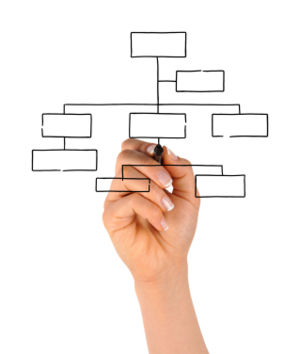Traditional Organizational Structure
Traditional organizational structure is a strategy for the organization of a company or person in what is known as a hierarchy or a top-down structure. With this approach, the processes of allocation and management of activities on a vertical structure defines a rigid chain of focus command.
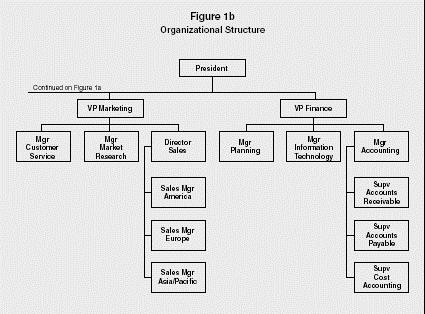
Hierarchy organizational structure is mainly developed to organize huge number of organizations including non-profit organizations and small business. On the other hand traditional type of organizational structure can often be effective when competent people are in positions of authority, and often there are also potential pitfalls with this model, which include the lack of checks and balances. The creativity of the organization may be limited in this type of business structure, because the ideas of a relatively small number of people who are actually involved in the overall operation.
There are two basic types of this organizational structure. First is a Line approach, this strategy is supported by a very well-defined and rigid chain of command that ultimately bear the responsibility and decision-making problems at the highest level of the structure. In little organizations, this strategy needs to be developed, since the company is consisted of one owner and more than one worker. This model can be problematic with the growth of organization.
A certain difference compared to the traditional organizational structure is known as the line and staff method. There is a well-defined chain of command, but the owner or CEO decides to delegate some of the responsibility for a small group of people, usually managers or supervisors. While the ability to cancel the decisions taken by the staff, the owner is usually solve issues that are of greater importance than, while human resource managers are needed to deal with other problems.
Over time, alternatives to the traditional organizational structure together. While the owners still get full control of a company, they tried to change the design so that employees indicated more input. The delegation of responsibilities to employees of great repute, announcing committees and other processes that can help in developing quick and easy communication between all levels organization all can enhance the productivity of the company and organization. At present, traditional organizational structure can deal at broader level with latest trends that can bring more chances of productivity of an organization.
In decision of choosing the organizational structure for the company, no doubt management will decide to choose the one that can bring parts of organization together with best coordination to make it effective and well efficient unit.
This is no doubt a very important and serious choice by the management. This is because the whole infrastructure will be based on the decided organizational structure. Some groups lead to a well-defined and mechanistic.
Before knowing more about traditional organizational structure it is very important to know about the types of traditional organizational structure.
Functional
This type of structure related to organization mainly groups people on basis of typical activities for maximum business – marketing, finance, human resources and production – then further subdivide them. This results in a vertical hierarchy.
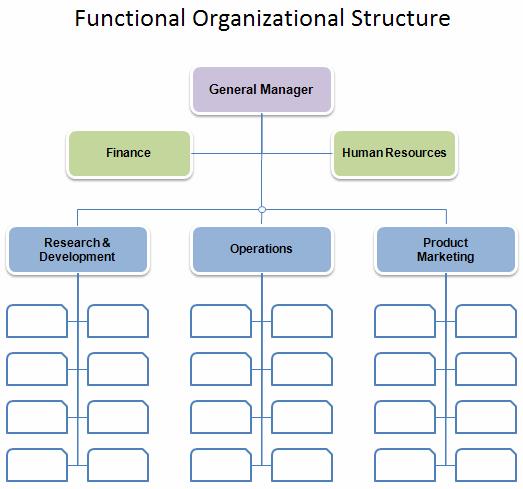
The advantages: efficiency and clear authority, responsibility and communication. Workers easily coordinate and communicate within their departments. Unfortunately causes a priority interdepartmental communication and coordination to suffer. Hierarchical levels mean ideas for change must be a bureaucratic chain of command. Functional structures are controlled and mechanized, but also less flexible and adaptable to changes in their environment.
Divisional
This structure actually groups company’s workers, depending on geography, product line, or customer. Each division operates as an independent company, complete with all the necessary functions, even if the management controls a couple of times more functional areas such as finance.
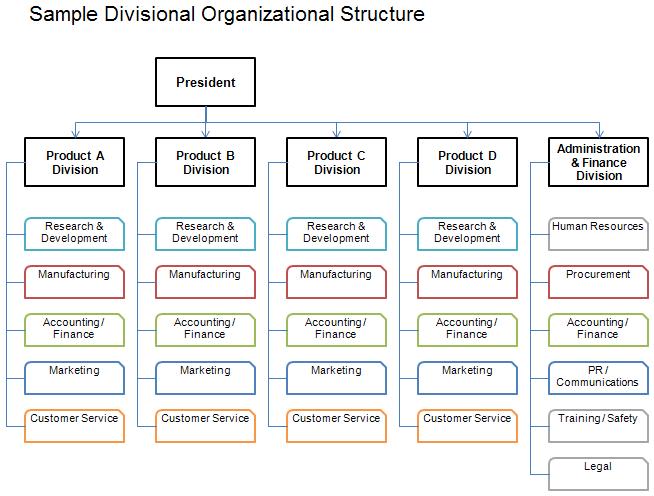
Duplication of functions is one of the disadvantages of this structure, as it means less efficiency and economy. In addition, the rivalry between divisions and poor communication and coordination between the units can be derived. However, the divisional structure allows each product line excel, to better respond to customer niche and capable geographical and cultural differences.
Matrix
The matrix structure operatively connected to substructures, including the benefits of both. Everyone has heard before a department, such as the production, reporting to a boss. Each person responds to a project team or business unit.
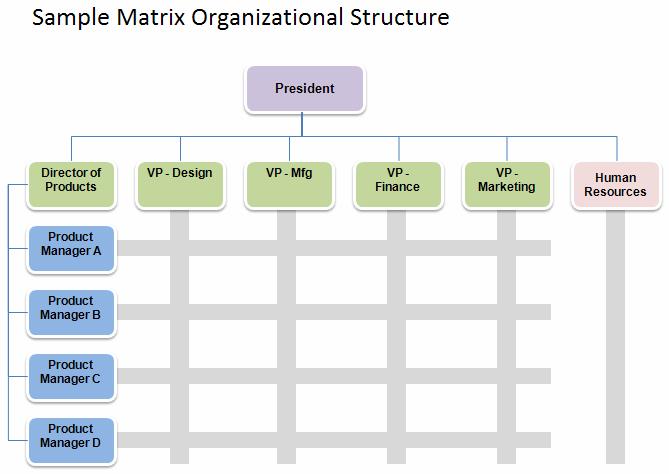
To qualify teams for the functional competence of the members, while the functional hierarchy exerts a degree of control and responsibility to society. The downside, of course, is that each of us has two bosses with possible conflicts of interest and loyalty.
Team
According to the team structure, the group of people has same goals. Every team has the goal of achieving accountability for performance results. The participants of the group are in power. The company does not lose levels of government, for the horizontal and vertical directions.
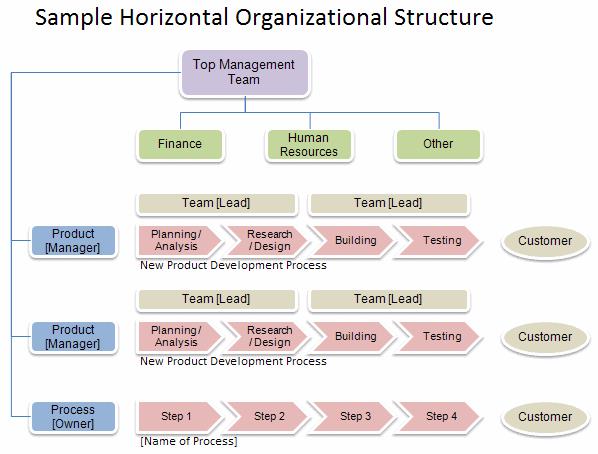
No chains of command decisions to be made quickly, and the company is adaptable and move freely on the market. Meanwhile, make the employees motivated with top performance. The risk of that structure is the need to monitor employees. Workers must be trained to meet the challenges.
Network
Instead of hiring employees for all business functions, a company only uses networks for better communication. The network companies are able to hire some workers, and enjoy the scope, performance and functionality of a large company. For example, you can connect external manufacturers to produce their products.
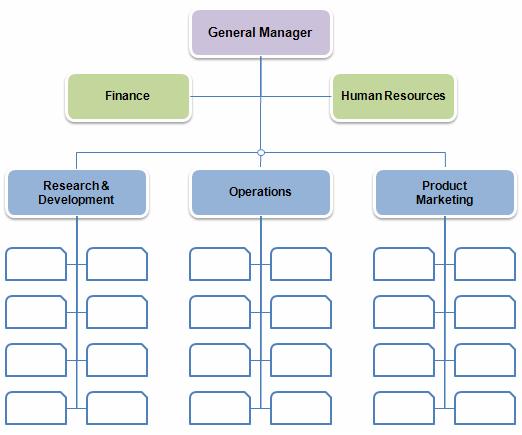
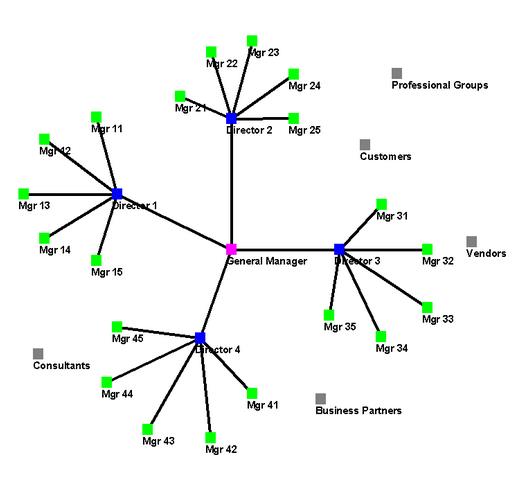
The network structure reduces the costs and gains flexibility because it uses outside help as needed. Starting a business, but this is losing control of the network that all business processes delegated to others.
A critical success factor for organizations today is ability to adapt their structures, systems, and existing process to win and develop new markets. A key factor in the strategy is the use of right organization of design. This article highlights the strategic importance of organizational planning for entrepreneurs and suggestions on how organizations can find the useful and most suitable designs for the success of their business.
After the choice of organizational structure the next step is to choose organizational design.
Organizational Design
Organizational structure refers to the type of image that a company uses for the flow of information on the organization of power and authority, roles and responsibilities. After the organization has elected its structure, they can go to the selection of designs. Organizational design is the process of review by the Management Company, the duties, functions and objectives of the company. Decisions about how people come together, to go to the best and most effective way to achieve their goals are very important.
The six most common approaches to organizational design is simple, functional, divisional – Team Matrix and network designs. A company is to choose its organizational structure, depending on their needs. The project is based on the organizational structure that is aligned with the economy at a given time. Mainly due to the organizations they are living, they will never be able to, as a matter of course, the best structure organization at the first attempt. Rather manager is the best structure through strategic assessment and reassessment of the tasks and groups of employees. Combinations must be developed in order to achieve the objectives and tasks of reorganizing these groups completely.
To define a better understanding of the concept of organizational design we will discuss the three best designs, also known as the traditional forms of organization, including the design of simple structures, functions and industries.
Simple Design Structure
The first type of traditional design is simple. Simple structure is a fundamental structure of organizational design with low departmentalization, little specialization of labor, wide spans of control, the central authority (usually the owner has most of the power), and little or formalization of the rules that operate on government . Organizations use a simple structure, usually are flat, because there are many levels of the hierarchy.
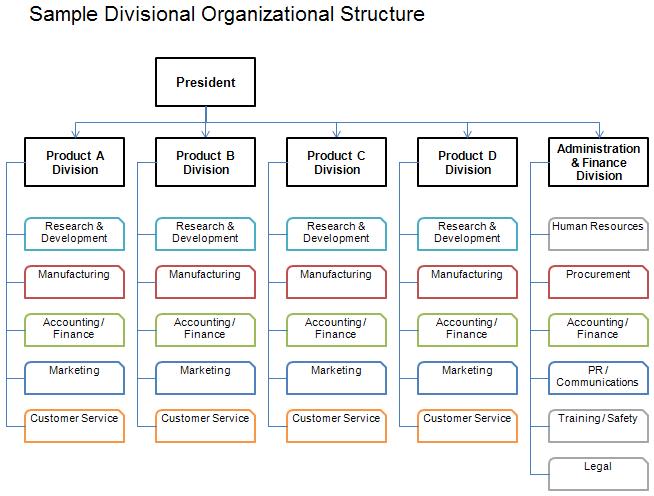
The simple structure is very common, with a few employees and an owner who manages and controls the majority of business functions. Since there are a limited number of employees of the landscaping company, it is necessary that each employee different functions in different areas of the organization, creating little, if any, departmentalization. Policies, procedures and rules are limited in the simple structure of the variety of taxes and limited specialization of labor. Of course, if the landscaping company expands, it will probably be too large to navigate design and simple to a more complex structure.
Functional Design
You can select the next type of organizational design that is the traditional functional structure. Functional design focuses on the specialized practice, similar or related occupational specialties (also known as departmentalization known).

Departmentalization groups of workers with similar tasks in work units on the basis of a product or service, carry out the activities of employees, skills and know-how, resources or types of customers. Title of work explicitly, can the chain of command, hierarchical relationships, and a communication channel well defined in these specialized units are working to maximize its functionality.
A functional organization is a strong hierarchy. With the idea of departmentalization, the organization in the individual departments, where each department has a specific function and all departments work independently to carry out organizational goals are shared. If you find a functional structure, you can see how the departments, such as sales and marketing, finance and accounting, customer service, human resources, planning and construction and maintenance, are grouped specialization. The design of the functional organization is more suitable when a company working on a single product or service, such as landscape. As a result, these devices can operate independently as sales and marketing, finance and accounting, customer service, human resources, design and construction, maintenance, and, every hour, on a specific task, manufacture and sale of packaging of that product or service.
Long-Term Planning
A partial structure design offers large businesses the ability to separate the majority of the division semi – autonomous or departments. These groups are self-managed and focused on a narrow aspect of the business with the objectives to be achieved. Examples of such divisions may be divided for providers who are covering the same geographic location or designers on the same product line.
Unlike departments, divisions have more autonomy from the rest of the organization, as they often have their own manager who manages the operations of the department. This autonomy allows managers, in particular on their individual unit to focus its resources and its results. Many believe that their leader is the thing to get success, because it ensures that a person who has the authority, power and resources are available at all times.
Globalization and the economic crisis is dating constant over the last three years that have forced companies to rethink their strategies and change their way of working. From what I understand, there was a lot of “up” with the companies put their focus on competing products or markets, rather than looking at the big picture. This can be a large number of initiatives bring gradual rather than trying the whole concept of organizational change.
For organizational changes in strategy, structure, roles and functions should be revised with new goals. This is not always the case, so that responsibility can not be ignored, the staff may not be enough working against each other.
There is a little more than a flattening of the traditional hierarchy, perhaps expanding into a matrix structure in parts of the organization. Often, however, remains the hierarchy in the “new” structure, which can be cut in all its power and leave people confused. Worse, organizations, to show people how rarely work in a new facility that can also affect performance.
Wrong choice of design and organizational structure results in a tangle of contradictions in the grove between the roles, the lack of coordination between functions, the lack of sharing of ideas and decisions of managers slow to bring unnecessary complexity, stress and conflict. Often those at the head of an organization are not aware of these problems.
Conclusion
Let’s review. Organizational design is the process of review by the Management Company, the duties, functions and objectives of the company. Decisions about how people meet are the best and most effective way to go to achieve their goals there are different forms of organizational design.
For the success of any organization it is necessary for it to to work out on specific structure and then make its organizational design on the basis of organizational structure. Organizational structure and organizational designs are both for the progress and success of the company and organization. It is up to the organization that its management chooses which structure and which design for the success of business.
Industry consolidation to large multinational companies through alliances and other types of cooperation between the authority’s efforts to create harmony, and the need of right organizational structure in the twenty-first century has become increasingly important. Sub-organizations of all sizes are thinking of manager’s influence on their organizational structure. One can not deny the importance of organizational structure for the ultimate success of a companies and organizations.
References
Brews, Peter J., and Christopher famous book “Exploring the Structural Effects of Internetworking.” Strategic Management Journal 25, published in 2004
Hansen, Morten T., and Nitin Nohria’s “How to Build Collaborative Advantage.” MIT Sloan Management Review
Ticoll, David’s “Get Self-Organized.” Harvard Business Review 82

